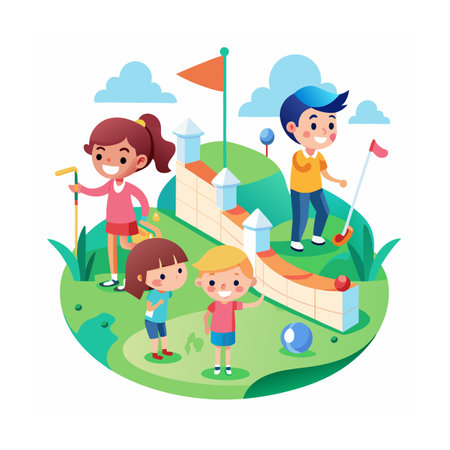Introduction to British Playground Games
British playground games have woven themselves into the fabric of childhood for generations, forming a cherished part of growing up across towns and villages in the UK. From bustling urban schoolyards to quiet village greens, traditional games like Bulldog, Hopscotch, and British Bulldog have long provided children with more than just entertainment—they offer a shared language of play that nurtures social bonds and physical activity. The history of these games stretches back centuries, reflecting the evolving customs and community spirit unique to British culture. Each game is marked by its own set of rules, rhythms, and rituals, often passed down through oral tradition. Their core characteristics—simple equipment, inclusivity, and imaginative adaptation—make them accessible to children from all walks of life. As we explore their origins and enduring cultural significance, it becomes clear that these playground favourites are not only fun but also powerful tools for learning, connection, and wellbeing.
Therapeutic Benefits for Children
Incorporating British playground games into therapeutic regimens offers a gentle yet powerful way to support children’s holistic well-being. These traditional activities, such as Hopscotch, British Bulldog, and What’s the Time, Mr Wolf?, are more than just playful diversions—they act as meaningful tools that foster physical, emotional, and social development in young participants undergoing therapy.
Physical Well-being
Many classic British playground games encourage movement, coordination, and balance. Activities like skipping rope or Duck, Duck, Goose involve running, hopping, or jumping, which can help children develop gross motor skills and improve their physical health. For those receiving physiotherapy or occupational therapy, these movements can be tailored to individual abilities, making exercises both enjoyable and motivating.
| Game | Physical Skills Developed |
|---|---|
| Hopscotch | Balance, coordination, leg strength |
| Skipping Rope | Cardiovascular endurance, timing, agility |
| What’s the Time, Mr Wolf? | Running speed, stopping/starting control |
Emotional Well-being
The familiarity and fun of playground games provide a sense of comfort and joy for children who may be experiencing stress or anxiety due to their therapeutic journey. Engaging in these activities allows them to express themselves freely and experience moments of laughter and accomplishment. The predictability of game rules also helps instil feelings of safety and trust—important foundations for emotional healing.
How Playground Games Support Emotional Health
- Confidence Building: Mastering the rules or achieving small goals boosts self-esteem.
- Anxiety Reduction: Repetitive play routines soothe nerves and promote relaxation.
- Resilience: Navigating wins and losses teaches coping skills in a supportive setting.
Social Well-being
British playground games naturally bring children together, fostering important social skills such as turn-taking, communication, and teamwork. For children who may find social situations challenging—such as those with autism spectrum conditions or selective mutism—games offer structured yet flexible opportunities to practise interaction in an inviting environment. Therapists can gently guide social exchanges within these playful contexts.
Examples of Social Skills Developed Through Play
- Turn-taking: Essential for group games like Conkers or Stuck in the Mud.
- Listening: Following instructions during Simon Says or Red Rover.
- Empathy: Supporting peers during team-based activities.
The integration of beloved British playground games into therapy not only supports children’s physical rehabilitation but also nurtures their emotional resilience and social confidence—laying the groundwork for brighter tomorrows with every playful step.

3. Practical Integration into Therapeutic Regimens
Bringing traditional British playground games into therapeutic settings can be a gentle yet powerful way to support childrens emotional and physical wellbeing. Practitioners and caregivers can thoughtfully weave these playful activities into daily routines, creating moments of joy, connection, and growth.
Start with Familiar Favourites
Begin by introducing well-loved British games such as “What’s the Time, Mr Wolf?”, “Duck, Duck, Goose”, or “Hopscotch”. These classics are easy to learn and require minimal equipment. For example, “Hopscotch” can be drawn with chalk in a garden or indoor space, encouraging children to move their bodies while practising turn-taking and counting skills.
Adapt Games to Suit Therapeutic Goals
Practitioners can gently modify rules or objectives to align with each child’s needs. For instance, if focusing on social interaction, “Stuck in the Mud” provides opportunities for teamwork and communication. The game can be slowed down or simplified so that every child feels included and supported. Caregivers might use positive reinforcement during play, offering kind words for effort and cooperation.
Embed Play Into Daily Routines
Playground games need not be reserved for therapy sessions alone. Encourage families to incorporate short bursts of play after school or before mealtimes. Even five minutes of “Simon Says” can help children regulate energy levels and develop listening skills. By making play a natural part of the day, practitioners and caregivers create safe spaces where children feel understood and valued.
Create Inclusive Environments
It is important to adapt games for varying abilities, ensuring that all children can participate comfortably. Use gentle guidance and invite input from the children themselves about which games they enjoy or how they might like to play. This collaborative approach fosters trust and builds confidence within therapeutic relationships.
By mindfully integrating British playground games into therapeutic regimens, practitioners and caregivers offer children not just support but also cherished memories—reminding them that healing can be both nurturing and fun.
4. Adapting Games for Inclusivity
Ensuring that every child feels welcome and able to participate in playground activities is at the heart of therapeutic play. British playground games, such as “What’s the Time, Mr Wolf?”, “Duck, Duck, Goose”, and “Stuck in the Mud”, can be thoughtfully adapted so children with diverse needs are included and supported. Below, you’ll find gentle suggestions and practical tips for modifying these beloved games to create a more inclusive environment.
Assessing Children’s Needs
The first step in adapting games is understanding the individual requirements of each child. Some may need physical support, while others might benefit from sensory adjustments or clearer communication. By observing and consulting with children and their carers, therapists can create a warm, welcoming space where everyone is encouraged to join in.
Practical Modifications for Popular Games
| Game | Possible Adaptation | Benefit |
|---|---|---|
| What’s the Time, Mr Wolf? | Use visual cards or hand signals alongside verbal cues for children with hearing impairments or language difficulties. | Enhances understanding and participation for all children. |
| Duck, Duck, Goose | Allow children with mobility needs to tap hands instead of running, or use supportive seating arrangements in a circle. | Promotes involvement without physical strain or exclusion. |
| Stuck in the Mud | Introduce a “buddy” system so peers can assist children who need help moving; allow modifications such as being ‘unstuck’ by touch on the arm rather than tagging legs. | Fosters teamwork and ensures everyone can experience success. |
Sensory-Friendly Adjustments
Some children may find loud noises or crowded spaces overwhelming. Consider holding games in quieter areas of the playground or using soft-spoken instructions. Providing noise-reducing headphones or offering breaks allows children to regulate their sensory experience while still feeling part of the group.
Encouraging Choice and Autonomy
Invite children to express their preferences—perhaps choosing which role they’d like to play or helping to set game rules. This sense of agency helps each child feel valued and strengthens confidence within the group setting.
A Culture of Kindness and Patience
Above all, fostering an atmosphere of kindness allows every child to thrive. Encourage peers to celebrate effort over achievement and model patience when learning new adaptations together. When inclusivity becomes second nature, therapeutic play transforms into a truly meaningful experience for all involved.
5. Case Studies and Anecdotal Evidence
Across the United Kingdom, many practitioners have begun to share their positive experiences of weaving traditional playground games into therapeutic routines for children. For example, a paediatric occupational therapist in Manchester recounts how introducing “Duck, Duck, Goose” helped a group of children with social anxiety gradually become more comfortable with spontaneous interaction and physical closeness. She observed that the familiar structure of the game provided a safe environment for hesitant participants, fostering both confidence and laughter.
Similarly, in a London-based speech and language therapy setting, therapists found “What’s the Time, Mr Wolf?” invaluable for supporting children with communication difficulties. The anticipation and repetition involved in the game encouraged vocal participation, turn-taking, and attentive listening—all vital skills that transferred to other aspects of each child’s daily routine.
Another inspiring story comes from a community centre in Birmingham, where a play therapist used “Stuck in the Mud” to help children process feelings of isolation and exclusion. Through gentle facilitation, children learned to work as a team to “free” one another, sparking conversations about friendship and emotional resilience that continued beyond the playground. Practitioners noted improvements not only in emotional expression but also in cooperation and problem-solving abilities.
These reflective stories highlight the adaptability of British playground games within therapeutic frameworks. Many therapists emphasise the importance of tailoring activities to each child’s unique needs while honouring their cultural context. By integrating these beloved games into sessions, practitioners offer children familiar touchpoints amidst new challenges, creating therapeutic experiences that feel both safe and joyful.
6. Considerations and Safety Guidance
When weaving beloved British playground games into therapeutic regimens for children, it is essential to create an environment where safety, respect, and individual growth are prioritised. These games, from hopscotch to Bulldog, offer not only joy but also opportunities for meaningful development. However, ensuring that each child feels secure and valued takes thoughtful planning and gentle vigilance.
Prioritising Physical and Emotional Safety
Assessing the Environment
Begin by evaluating the play area—whether it’s a school playground or a community centre—to eliminate potential hazards. Ensure surfaces are even, equipment is well-maintained, and boundaries are clear. Supervision is key: adults should remain present and attentive, ready to step in if games become too boisterous or competitive.
Adapting Rules with Sensitivity
While tradition is precious, be prepared to adapt classic game rules to fit each child’s abilities and comfort levels. For instance, you might modify the pace of Duck Duck Goose or set gentler boundaries for games like Stuck in the Mud. Encourage children to express their feelings about participation and be receptive if they need breaks or alternative roles.
Fostering Respectful Interactions
Promoting Kindness and Inclusion
Create a culture of encouragement by modelling respectful language and behaviour. Remind children that everyone’s contribution matters—whether they’re leading a round of What’s the Time, Mr Wolf? or quietly observing from the sidelines. Celebrate effort over achievement to ensure no one feels left behind.
Honouring Each Child’s Journey
No two children follow the same path, and their needs may shift from day to day. Invite open dialogue with both children and families about what feels comfortable and enjoyable. By honouring each unique journey while drawing on the warmth of shared traditions, you help every child feel seen, safe, and supported as they play and grow together.
7. Conclusion and Future Directions
Blending British playground games with therapeutic regimens offers a unique opportunity to enrich childrens developmental journeys in ways that are both joyful and meaningful. These time-honoured games—from hopscotch to stuck in the mud—are woven into the fabric of British childhood, carrying with them not only laughter and camaraderie but also skills that are foundational for emotional, social, and physical wellbeing. When thoughtfully integrated into therapeutic work, they can gently unlock communication, nurture trust, and encourage healthy risk-taking in a familiar, child-centred environment. As practitioners and caregivers, there is value in remaining open to innovative approaches rooted in local culture and tradition. By listening to children’s voices and observing their responses, we can continue evolving our methods, making space for playful interventions that respect individuality while fostering holistic growth. Let us warmly embrace this spirit of exploration, confident that weaving together therapeutic intention with the simple joys of playground play will light new pathways toward resilience and wellbeing for every child.


